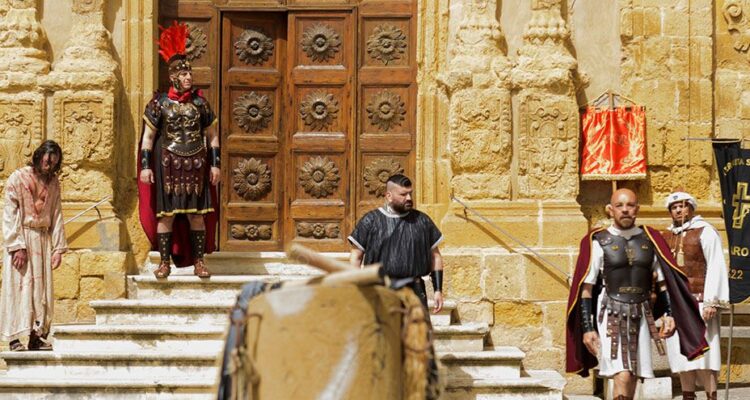Sacri rappresentazioni della passione di Cristo or
Sacred representations of the Passion of Christ
For someone who has researched Sicilian theatre all their professional life, I have never quite seen a performance like this before. Having grown up in London listening to stories about the procession in Naro, my family’s hometown in the province of Agrigento in Sicily, the thought of following a street performance representing the Passion of Christ through the local streets never sounded particularly cool. Fast forward to 2024 and I am literally blown away.
The Good Friday Easter Procession is a street performance which, in Naro, originated in 1759. These traditions are held in many small towns in Sicily each with a local take on this important religious occasion. This year, the procession was performed by members of the theatre company, iContemplAttivi, directed by Massimiliano Arena.
In Naro, the day’s event is divided into two parts: the main procession from Jesus’s condemnation to death, and the aftermath of his crucifixion in the late afternoon where the statues of Jesus and the Madonna are carried up to the Mother Church, accompanied by an orchestra, and Jesus is symbolically laid to rest. The script is based on Adam’s Ransom, which dates to 1750. This is a tragedy in three acts, also known as The Martyrdom of Jesus Christ by the poet and playwright from Palermo, Orioles Philip (circa 1687-1793). The dialogue is performed in Italian – not Sicilian – and incorporated within the performance are other excepts, including the touching Mary’s Anguish at the Sepulchre by the contemporary, Totò Nocera, which is staged at the Mother Church to conclude the day.
What is striking about this performance is the importance of historical memory for the people of Naro aligned with the sense of community which ensures that this long tradition continues. It is a religious festival but also a civic event. Firstly, the way in which memorials, churches, and town buildings are used as part of the production is fascinating. For instance, Piazza Garibaldi is used in the opening scene as a stage where Jesus is condemned to death.
In addition, local streets are used where the actor performing Jesus (Vincent Cancemi ) is made to carry a large black cross through the town among the whips of the Romans. Each time Jesus falls on the ground, a prayer is given by one of the leading priests, after which the procession continues through the town. A form of worship through performance.
But more than a traditional, religious procession, this is a social celebration. Most of the community attends the event, from the older generations right to the youngest, forming a kind of collective performance. There are those who wave from the balcony; others who watch the procession standing by the main streets; and those who participate in the procession by walking next to the actors dressed in Roman robes. The Mayor also attends, on this occasion wearing an Italian tricolour strip and giving one of the closing prayers.
As a break from tradition where the performers allegedly wept and howled, Cancemi hardly speaks a word in his role as Christ. His physical reactions to the violence faced, above all his facial expressions coupled with realistic makeup by Eugenio Scanio, are extremely moving. The tender mother-and-son relationship portrayed by Cancemi and Linda Arnone is nothing but powerful. As Jesus drops to his feet carrying the cross, his mother, like many other of the female saints, come to his side to wipe his face. The performance by Arnone, in particular, is so realistic that she shed real tears during these encounters.
What also adds to the power of the performance is the use of music. As a break from the funeral music typically employed, the scenes where Jesus is being attacked by the Romans is accompanied by American hard rock. This not only helps to convey the biblical story to modern audiences, but also – cleverly – enables the actors, like Giuseppe Pirriatore, to raise their voices and amplify their intense shouting.
In more sombre moments, gentle music is employed. This occurs specifically when Jesus arrives at his crucifixion, where the procession comes to an end. This is staged at a memorial cross paying tribute to Calvary. Just before the crucifixion, the performance gives space to the priests for a moment a worship. When Jesus is crucified, a statue from one of the local churches is carried up the cross on a ladder by two priests on either side using ropes as they tie the statue up at the top.
One of the most moving performances was by Judas, interpreted by Dino Nicotra. In a loud and horrified “Cosa ho fatto?” (“What have I done?”), we are uniquely invited to see the reaction of Judas as he stands right in front of the statue on the cross. In this agonising moment, audiences are made to see his complexities come to life – his regret, furious pride, and refusal for forgiveness – rendering this production all the more modern as we witness the complications behind what has traditionally been portrayed as a demonic figure.
It is remarkable that this production should be interpreted, produced, and directed by non-professional volunteers, and brought to life from generous donations. A big round of applause to the director, Massimiliano Arena, for bringing this artistic street performance all together so flawlessly, a relief from the modern technological world where local tradition, cultural heritage, and community spirit are becoming hard to come by.
Location: Naro, in the province of Agrigento in Sicily
Director: Massimiliano Arena
Performed by members of the theatre company, iContemplAttivi,
Jesus performed by Vincent Cancemi
For more information, please see: www.icontemplattivi.it

